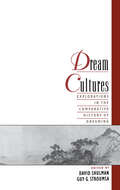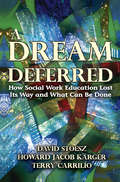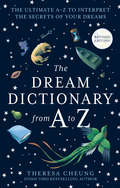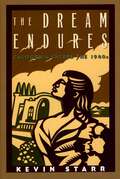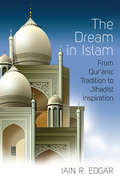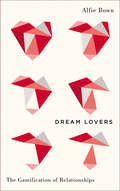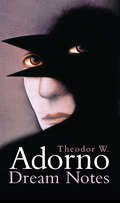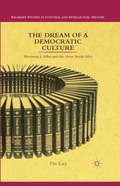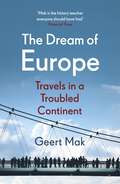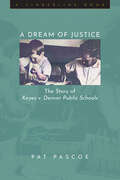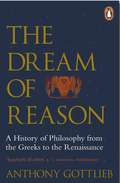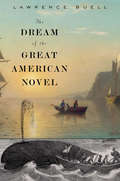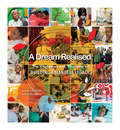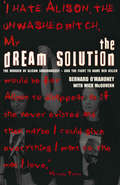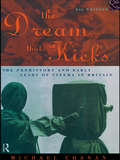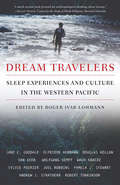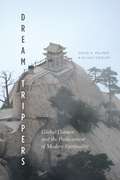- Table View
- List View
Dream Cultures: Explorations in the Comparative History of Dreaming
by David Shulman Guy G. StroumsaThis volume offers a comparative, cross-cultural history of dreams. The essays examine a wide range of texts concerning dreams, as culled from a rich variety of religious contexts: China, India, the Americas, classical Greek and Roman antiquity, early Christianity, and medieval Judaism and Islam. Taken together, these pieces constitute an important first step toward a new understanding of the differences and similarities between the ways in which different cultures experience the universal yet utterly unique world of dreams.
A Dream Deferred: How Social Work Education Lost Its Way and What Can be Done
by Howard KargerFrom its inception in the late nineteenth century, social work has struggled to carry out the complex, sometimes contradictory, functions associated with reducing suffering, enhancing social order, and social reform. Since then, social programs like the implementation of welfare and the expansion of the service economy-which should have augured well for American social work-instead led to a continued loss of credibility with the public and within the academy.A Dream Deferred chronicles this decline of social work, attributing it to the poor quality of professional education during the past half-century. The incongruity between social work's promise and its performance warrants a critical review of professional education. For the past half-century, the fortunes of social work have been controlled by the Council of Social Work Education, which oversees accreditation of the nation's schools of social work. Stoesz, Karger, and Carrilio argue that the lack of scholarship of the Board of Directors compromises this accreditation policy. Similarly, the quality of professional literature suffers from the weak scholarship of editors and referees. The caliber of deans and directors of social work educational programs is low and graduate students are ill-prepared to commence studies in social work. Further complicating this debate, the substitution of ideology for academic rigor makes social work vulnerable to its critics.The authors state that, since CSWE is unlikely to reform social work education, schools of social work should be free to obtain accreditation independently, and they propose criteria for independent accreditation. A Dream Deferred builds on the past, presents a bracing critique of the present, and proposes recommendations for a better future that cannot be ignored or dismissed.
A Dream Deferred: How Social Work Education Lost Its Way and What Can be Done
by Howard KargerFrom its inception in the late nineteenth century, social work has struggled to carry out the complex, sometimes contradictory, functions associated with reducing suffering, enhancing social order, and social reform. Since then, social programs like the implementation of welfare and the expansion of the service economy-which should have augured well for American social work-instead led to a continued loss of credibility with the public and within the academy.A Dream Deferred chronicles this decline of social work, attributing it to the poor quality of professional education during the past half-century. The incongruity between social work's promise and its performance warrants a critical review of professional education. For the past half-century, the fortunes of social work have been controlled by the Council of Social Work Education, which oversees accreditation of the nation's schools of social work. Stoesz, Karger, and Carrilio argue that the lack of scholarship of the Board of Directors compromises this accreditation policy. Similarly, the quality of professional literature suffers from the weak scholarship of editors and referees. The caliber of deans and directors of social work educational programs is low and graduate students are ill-prepared to commence studies in social work. Further complicating this debate, the substitution of ideology for academic rigor makes social work vulnerable to its critics.The authors state that, since CSWE is unlikely to reform social work education, schools of social work should be free to obtain accreditation independently, and they propose criteria for independent accreditation. A Dream Deferred builds on the past, presents a bracing critique of the present, and proposes recommendations for a better future that cannot be ignored or dismissed.
The Dream Dictionary from A to Z [Revised edition]: The Ultimate A-z To Interpret The Secrets Of Your Dreams
by Theresa CheungIn this newly revised and updated edition, unlock the secrets of your dreamlife with the most comprehensive A–Z reference book on dream interpretation you'll ever find.
The Dream Endures: California Enters the 1940s (Americans and the California Dream)
by Kevin StarrWhat we now call "the good life" first appeared in California during the 1930s. Motels, home trailers, drive-ins, barbecues, beach life and surfing, sports from polo and tennis and golf to mountain climbing and skiing, "sportswear" (a word coined at the time), and sun suits were all a part of the good life--perhaps California's most distinctive influence of the 1930s. In The Dream Endures, Kevin Starr shows how the good life prospered in California--in pursuits such as film, fiction, leisure, and architecture--and helped to define American culture and society then and for years to come. Starr previously chronicled how Californians absorbed the thousand natural shocks of the Great Depression--unemployment, strikes, Communist agitation, reactionary conspiracies--in Endangered Dreams, the fourth volume of his classic history of California. In The Dream Endures, Starr reveals the other side of the picture, examining the newly important places where the good life flourished, like Los Angeles (where Hollywood lived), Palm Springs (where Hollywood vacationed), San Diego (where the Navy went), the California Institute of Technology in Pasadena (where Einstein went and changed his view of the universe), and college towns like Berkeley. We read about the rich urban life of San Francisco and Los Angeles, and in newly important communities like Carmel and San Simeon, the home of William Randolph Hearst, where, each Thursday afternoon, automobiles packed with Hollywood celebrities would arrive from Southern California for the long weekend at Hearst Castle. The 1930s were the heyday of the Hollywood studios, and Starr brilliantly captures Hollywood films and the society that surrounded the studios. Starr offers an astute discussion of the European refugees who arrived in Hollywood during the period: prominent European film actors and artists and the creative refugees who were drawn to Hollywood and Southern California in these years--Igor Stravinsky, Arnold Schoenberg, Man Ray, Bertolt Brecht, Christopher Isherwood, Aldous Huxley, Thomas Mann, and Franz Werfel. Starr gives a fascinating account of how many of them attempted to recreate their European world in California and how others, like Samuel Goldwyn, provided stories and dreams for their adopted nation. Starr reserves his greatest attention and most memorable writing for San Francisco. For Starr, despite the city's beauty and commercial importance, San Francisco's most important achievement was the sense of well-being it conferred on its citizens. It was a city that "magically belonged to everyone." Whether discussing photographers like Edward Weston and Ansel Adams, "hard-boiled fiction" writers, or the new breed of female star--Marlene Dietrich, Jean Harlow, Bette Davis, Carole Lombard, and the improbable Mae West--The Dream Endures is a brilliant social and cultural history--in many ways the most far-reaching and important of Starr's California books.
The Dream in Islam: From Qur'anic Tradition to Jihadist Inspiration
by Iain R. EdgarThe war in the Middle East is marked by a lack of cultural knowledge on the part of the western forces, and this book deals with another, widely ignored element of Islam—the role of dreams in everyday life. The practice of using night dreams to make important life decisions can be traced to Middle Eastern dream traditions and practices that preceded the emergence of Islam. In this study, the author explores some key aspects of Islamic dream theory and interpretation as well as the role and significance of night dreams for contemporary Muslims. In his analysis of the Islamic debates surrounding the role of “true” dreams in historical and contemporary Islamic prophecy, the author specifically addresses the significance of Al-Qaeda and Taliban dream practices and ideology. Dreams of “heaven,” for example, are often instrumental in determining Jihadist suicidal action, and “heavenly” dreams are also evidenced within other contemporary human conflicts such as Israel–Palestine and Kosovo–Serbia. By exploring patterns of dreams within this context, a cross-cultural, psychological, and experiential understanding of the role and significance of such contemporary critical political and personal imagery can be achieved.
Dream Lovers: The Gamification of Relationships (Digital Barricades)
by Alfie BownWe are in the middle of a 'desirevolution' - a fundamental and political transformation of the way we desire as human beings. Perhaps as always, new technologies - with their associated and inherited political biases - are organising and mapping the future. What we don’t seem to notice is that the primary way in which our lives are being transformed is through the manipulation and control of desire itself. Our very impulses, drives and urges are 'gamified' to suit particular economic and political agendas, changing the way we relate to everything from lovers and friends to food and politicians. Digital technologies are transforming the subject at the deepest level of desire – re-mapping its libidinal economy - in ways never before imagined possible. From sexbots to smart condoms, fitbits to VR simulators and AI to dating algorithms, the 'love industries' are at the heart of the future smart city and the social fabric of everyday life. This book considers these emergent technologies and what they mean for the future of love, desire, work and capitalism.
Dream Notes
by Theodor W. Adorno"Dreams are as black as death." —Theodor W. Adorno Adorno was fascinated by his dreams and wrote them down throughout his life. He envisaged publishing a collection of them although in the event no more than a few appeared in his lifetime. Dream Notes offers a selection of Adornos writings on dreams that span the last twenty-five years of his life. Readers of Adorno who are accustomed to high-powered reflections on philosophy, music and culture may well find them disconcerting: they provide an amazingly frank and uninhibited account of his inner desires, guilt feelings and anxieties. Brothel scenes, torture and executions figure prominently. They are presented straightforwardly, at face value. No attempt is made to interpret them, to relate them to the events of his life, to psychoanalyse them, or to establish any connections with the principal themes of his philosophy. Are they fiction, autobiography or an attempt to capture a pre-rational, quasi-mythic state of consciousness? No clear answer can be given. Taken together they provide a highly consistent picture of a dimension of experience that is normally ignored, one that rounds out and deepens our knowledge of Adorno while retaining something of the enigmatic quality that energized his own thought.
Dream Notes
by Theodor W. Adorno"Dreams are as black as death." —Theodor W. Adorno Adorno was fascinated by his dreams and wrote them down throughout his life. He envisaged publishing a collection of them although in the event no more than a few appeared in his lifetime. Dream Notes offers a selection of Adornos writings on dreams that span the last twenty-five years of his life. Readers of Adorno who are accustomed to high-powered reflections on philosophy, music and culture may well find them disconcerting: they provide an amazingly frank and uninhibited account of his inner desires, guilt feelings and anxieties. Brothel scenes, torture and executions figure prominently. They are presented straightforwardly, at face value. No attempt is made to interpret them, to relate them to the events of his life, to psychoanalyse them, or to establish any connections with the principal themes of his philosophy. Are they fiction, autobiography or an attempt to capture a pre-rational, quasi-mythic state of consciousness? No clear answer can be given. Taken together they provide a highly consistent picture of a dimension of experience that is normally ignored, one that rounds out and deepens our knowledge of Adorno while retaining something of the enigmatic quality that energized his own thought.
The Dream of a Democratic Culture: Mortimer J. Adler and the Great Books Idea (Palgrave Studies in Cultural and Intellectual History)
by T. LacyThis book presents a moderately revisionist history of the great books idea anchored in the following movements and struggles: fighting anti-intellectualism, advocating for the liberal arts, distributing cultural capital, and promoting a public philosophy, anchored in mid-century liberalism, that fostered a shared civic culture.
The Dream of Europe: Travels in the Twenty-First Century
by Geert Mak'Mak is the history teacher everyone should have had' Financial TimesHow did the great European dream turn sour? And where do we go from here?From the author of the internationally acclaimed In Europe, a stunning history of our present, examining the first two decades of this most fragile and fraught new millennium.The great European project was built out of a common desire for peace, prosperity and freedom; a wish for a united Europe striving towards a common goal. The EU was to set an example: an arena for close cooperation, tackling crucial shared concerns from climate change to organized crime, promoting open borders and social security. But the first two turbulent decades of this century have been times of rapid and profound change. From the shores of Lampedusa to Putin's Moscow, the continent threatens to tear itself apart. What's happened to Europe's optimism and euphoria? How has it given way to nostalgia, frustration and fear, the fragile European dream in danger of turning into a nightmare?In The Dream of Europe, Geert Mak, one of Europe's best-loved commentators, charts the seismic events that have shaped people's lives over the past twenty years. Mak's monumental book In Europe defined the continent on the verge of a new millennium. The Dream of Europe brings us up to the present day, through the rocky expansion of the EU, the aftermath of 9/11 and terrorist attacks across Europe, the 2008 financial crash and the euro crisis, the tragedy of the migrant crisis in the Mediterranean, the rise of right-wing populism and Brexit.Like no other, Mak blends history, politics and culture with the stories and experiences of the many Europeans he meets on his travels. He brings this continent to life, and asks what role does Europe play now, and how might we face our challenges together, in the spirit of solidarity and connection.'A powerful, humane and serious mind' Guardian'Mak is a truly cosmopolitan chronicler' IndependentPraise for In Europe:'Fascinating... a splendidly panoramic picture of our common European home' Literary Review 'Every page sparkles with insight' Herald'Spectacular and beautifully crafted' Sunday Times
A Dream of Justice: The Story of Keyes v. Denver Public Schools (Timberline Books)
by Pat PascoeA Dream of Justice is Colorado state senator and former teacher Pat Pascoe’s firsthand account of the decades-long fight to desegregate Denver’s public schools. Drawing on oral histories and interviews with members of the legal community, parents, and students, as well as extensive institutional records, Pascoe offers a compelling social history of Keyes v. School District No. 1 (Denver). Pascoe details Denver’s desegregation battle, beginning with the citizen studies that exposed the inequities of segregated schools and Rachel Noel’s resolution to integrate the system, followed by the momentous pro-integration Benton-Pascoe campaign of Ed Benton and Monte Pascoe for the school board in 1969. When segregationists won that election and reversed the integration plan for northeast Denver, Black, white, and Latino parents filed Keyes v. School District No. 1. This book follows the arguments in the case through briefs, transcripts, and decisions from district court to the Supreme Court of the United States and back, to its ultimate order to desegregate all Denver schools “root and branch.” It was the first northern city desegregation suit to be brought before the Supreme Court. However, with the end of court-ordered busing in 1995, schools quickly resegregated and are now more segregated than before Keyes was filed. Pascoe asserts that school integration is a necessary step toward eliminating systemic racism in our country and should be the objective of every school board. A Dream of Justice will appeal to students, scholars, and readers interested in the history of civil rights in America, Denver history, and the history of US education.
The Dream of Reason: A History of Western Philosophy from the Greeks to the Renaissance
by Anthony GottliebAlready a classic, this landmark account of early Western thought now appears in a new edition with expanded coverage of the Middle Ages. The Dream of Reason takes a fresh look at the writings of the great thinkers of classic philosophy and questions many pieces of conventional wisdom. The book invites comparison with Bertrand Russell's monumental History of Western Philosophy, "but Gottlieb's book is less idiosyncratic and based on more recent scholarship" (Colin McGinn, Los Angeles Times). A New York Times Notable Book, a Los Angeles Times Best Book, and a Times Literary Supplement Best Book of 2001.
The Dream Of The Great American Novel
by Lawrence BuellThe idea of "the great American novel" continues to thrive almost as vigorously as in its nineteenth-century heyday, defying 150 years of attempts to dismiss it as amateurish or obsolete. In this landmark book, the first in many years to take in the whole sweep of national fiction, Lawrence Buell reanimates this supposedly antiquated idea, demonstrating that its history is a key to the dynamics of national literature and national identity itself. The dream of the G.A.N., as Henry James nicknamed it, crystallized soon after the Civil War. In fresh, in-depth readings of selected contenders from the 1850s onward in conversation with hundreds of other novels, Buell delineates four "scripts" for G.A.N. candidates. One, illustrated by The Scarlet Letter, is the adaptation of the novel's story-line by later writers, often in ways that are contrary to the original author's own design. Other aspirants, including The Great Gatsby and Invisible Man, engage the American Dream of remarkable transformation from humble origins. A third script, seen in Uncle Tom's Cabin and Beloved, is the family saga that grapples with racial and other social divisions. Finally,mega-novels from Moby-Dick to Gravity's Rainbow feature assemblages of characters who dramatize in microcosm the promise and pitfalls of democracy. The canvas of the great American novel is in constant motion, reflecting revolutions in fictional fashion, the changing face of authorship, and the inseparability of high culture from popular. As Buell reveals, the elusive G.A.N. showcases the myth of the United States as a nation perpetually under construction.
A Dream Realised: The Challenges and Triumphs of Building a Mandela Legacy
by Ulrike Hill Zanele Chakela‘How can there be only one dedicated hospital in the country for our children?’ When Madiba asked this question, he sowed the seeds of a challenge that would grow into a legacy.A seed may be small but its size is disproportionate to what it can become over time. The Nelson Mandela Children’s Hospital was a project that seemed impossible when it was just an idea that started with ten people seated around a dinner table. As they discussed the state of healthcare in the country and shared their experiences, they realised that it was the children of Southern Africa who were the most disadvantaged by the lack of dedicated paediatric facilities. At the end of the evening a statement by the late Dr Nthato Motlana took hold and became the catalyst for a remarkable journey: ‘I will speak to Nelson,’ he said.With South Africa’s first democratically elected president Nelson Mandela’s backing, the board of the Children’s Fund was inspired to take up the challenge to address this vital need. After years of global research and advice from experts in numerous different fields a Trust was formed to oversee the project and, critically, to set about raising the one billion rand it would take to build, equip and staff a state-of-the-art children’s hospital.The stories behind the planning for, fundraising and building of the Nelson Mandela Children’s Hospital are inspiring, personal, and sometimes heart-breaking. It was a long and arduous journey, beset with difficulties, but the dedicated team’s commitment and courage prevailed to create a living legacy that will truly impact the lives of children for generations to come.Today, the Nelson Mandela Children’s Hospital in Johannesburg is a proud testimony to a uniquely African story which honours the memory of a great statesman and celebrates the children for whom he cared so deeply.
The Dream Solution: The Murder of Alison Shaughnessy - and the Fight to Name Her Killer
by Bernard O'Mahoney Mick McGovernFollowing Michelle and Lisa Taylor's conviction of the savage murder of Alison Shaugnessy, Bernard O'Mahoney embarked on a successful crusade to prove their innocence. Michelle - who had been having an affair with Alison's husband - had been found guilty of murdering Alison in a jealous rage, and her sister, Lisa, was convicted of aiding her in the brutal attack. During the appeal to clear their names, Bernard O'Mahoney and Michelle began a passionate affair. Then, his suspicions aroused by her obsessive behaviour, O'Mahoney stumbled across a letter which could only mean one thing - Michelle was guilty. Following a heated confrontation, she finally broke down and admitted her guilt. The Dream Solution tells of two dramatic legal battles - one to free the sisters, and the other to prove their guilt.
The Dream That Kicks: The Prehistory and Early Years of Cinema in Britain
by Professor Michael Chanan Michael ChananThe Dream the Kicks is a classic account of the prehistory and early years of cinema in Britain. In this new paperback edition, which has been thoroughly revised to take into account recent scholarship of early cinema, Michael Chanan provides a fasciniating account of the rich and hitherto hidden history of the origins of film. Chanan demonstrates that the theory of `the persistence of vision', which led to the invention of moving pictures, has been superceded by modern scientific findings. In its place, he puts forward a theory of invention as a type of bricolage, and shows that cinematography was a product of the forces of nineteenth century capitalism. He discusses the wealth of influences, both popular and bourgeois, on the culture of early cinema, including diorama, the magic lantern, itinerant entertainers and music hall. He looks at the relationship between film and photography, and considers the nascent film business, the ways in which early cinema was received by its audiences and the developing aesthetics of cinema in its first fifteen years.
The Dream That Kicks: The Prehistory and Early Years of Cinema in Britain
by Professor Michael Chanan Michael ChananThe Dream the Kicks is a classic account of the prehistory and early years of cinema in Britain. In this new paperback edition, which has been thoroughly revised to take into account recent scholarship of early cinema, Michael Chanan provides a fasciniating account of the rich and hitherto hidden history of the origins of film. Chanan demonstrates that the theory of `the persistence of vision', which led to the invention of moving pictures, has been superceded by modern scientific findings. In its place, he puts forward a theory of invention as a type of bricolage, and shows that cinematography was a product of the forces of nineteenth century capitalism. He discusses the wealth of influences, both popular and bourgeois, on the culture of early cinema, including diorama, the magic lantern, itinerant entertainers and music hall. He looks at the relationship between film and photography, and considers the nascent film business, the ways in which early cinema was received by its audiences and the developing aesthetics of cinema in its first fifteen years.
Dream Travelers: Sleep Experiences and Culture in the Western Pacific
by R. LohmannIn dreams, part of the self seems to wander off to undertake both mundane tasks and marvellous adventures. Anthropologists have found that many peoples take this experience of dreaming at face value, assuming that their spirits literally leave the body to travel, meet other spirits, and acquire valuable knowledge - with dramatic consequence for relationships, social organization, and religions. Dream Travellers is about Melanesian, Aboriginal Australian, and Indonesian peoples who hold this assumption. Several leading anthropologists contribute theoretically and ethnographically rich chapters, showing that attention to these peoples' dream lives deeply enhances our understanding of their cultures and waking lives as well.
Dream Trippers: Global Daoism and the Predicament of Modern Spirituality
by David A. Palmer Elijah SieglerOver the past few decades, Daoism has become a recognizable part of Western “alternative” spiritual life. Now, that Westernized version of Daoism is going full circle, traveling back from America and Europe to influence Daoism in China. Dream Trippers draws on more than a decade of ethnographic work with Daoist monks and Western seekers to trace the spread of Westernized Daoism in contemporary China. David A. Palmer and Elijah Siegler take us into the daily life of the monastic community atop the mountain of Huashan and explore its relationship to the socialist state. They follow the international circuit of Daoist "energy tourism," which connects a number of sites throughout China, and examine the controversies around Western scholars who become practitioners and promoters of Daoism. Throughout are lively portrayals of encounters among the book’s various characters—Chinese hermits and monks, Western seekers, and scholar-practitioners—as they interact with each other in obtuse, often humorous, and yet sometimes enlightening and transformative ways. Dream Trippers untangles the anxieties, confusions, and ambiguities that arise as Chinese and American practitioners balance cosmological attunement and radical spiritual individualism in their search for authenticity in a globalized world.
Dream Trippers: Global Daoism and the Predicament of Modern Spirituality
by David A. Palmer Elijah SieglerOver the past few decades, Daoism has become a recognizable part of Western “alternative” spiritual life. Now, that Westernized version of Daoism is going full circle, traveling back from America and Europe to influence Daoism in China. Dream Trippers draws on more than a decade of ethnographic work with Daoist monks and Western seekers to trace the spread of Westernized Daoism in contemporary China. David A. Palmer and Elijah Siegler take us into the daily life of the monastic community atop the mountain of Huashan and explore its relationship to the socialist state. They follow the international circuit of Daoist "energy tourism," which connects a number of sites throughout China, and examine the controversies around Western scholars who become practitioners and promoters of Daoism. Throughout are lively portrayals of encounters among the book’s various characters—Chinese hermits and monks, Western seekers, and scholar-practitioners—as they interact with each other in obtuse, often humorous, and yet sometimes enlightening and transformative ways. Dream Trippers untangles the anxieties, confusions, and ambiguities that arise as Chinese and American practitioners balance cosmological attunement and radical spiritual individualism in their search for authenticity in a globalized world.
Dream Trippers: Global Daoism and the Predicament of Modern Spirituality
by David A. Palmer Elijah SieglerOver the past few decades, Daoism has become a recognizable part of Western “alternative” spiritual life. Now, that Westernized version of Daoism is going full circle, traveling back from America and Europe to influence Daoism in China. Dream Trippers draws on more than a decade of ethnographic work with Daoist monks and Western seekers to trace the spread of Westernized Daoism in contemporary China. David A. Palmer and Elijah Siegler take us into the daily life of the monastic community atop the mountain of Huashan and explore its relationship to the socialist state. They follow the international circuit of Daoist "energy tourism," which connects a number of sites throughout China, and examine the controversies around Western scholars who become practitioners and promoters of Daoism. Throughout are lively portrayals of encounters among the book’s various characters—Chinese hermits and monks, Western seekers, and scholar-practitioners—as they interact with each other in obtuse, often humorous, and yet sometimes enlightening and transformative ways. Dream Trippers untangles the anxieties, confusions, and ambiguities that arise as Chinese and American practitioners balance cosmological attunement and radical spiritual individualism in their search for authenticity in a globalized world.
Dream Trippers: Global Daoism and the Predicament of Modern Spirituality
by David A. Palmer Elijah SieglerOver the past few decades, Daoism has become a recognizable part of Western “alternative” spiritual life. Now, that Westernized version of Daoism is going full circle, traveling back from America and Europe to influence Daoism in China. Dream Trippers draws on more than a decade of ethnographic work with Daoist monks and Western seekers to trace the spread of Westernized Daoism in contemporary China. David A. Palmer and Elijah Siegler take us into the daily life of the monastic community atop the mountain of Huashan and explore its relationship to the socialist state. They follow the international circuit of Daoist "energy tourism," which connects a number of sites throughout China, and examine the controversies around Western scholars who become practitioners and promoters of Daoism. Throughout are lively portrayals of encounters among the book’s various characters—Chinese hermits and monks, Western seekers, and scholar-practitioners—as they interact with each other in obtuse, often humorous, and yet sometimes enlightening and transformative ways. Dream Trippers untangles the anxieties, confusions, and ambiguities that arise as Chinese and American practitioners balance cosmological attunement and radical spiritual individualism in their search for authenticity in a globalized world.
Dream Trippers: Global Daoism and the Predicament of Modern Spirituality
by David A. Palmer Elijah SieglerOver the past few decades, Daoism has become a recognizable part of Western “alternative” spiritual life. Now, that Westernized version of Daoism is going full circle, traveling back from America and Europe to influence Daoism in China. Dream Trippers draws on more than a decade of ethnographic work with Daoist monks and Western seekers to trace the spread of Westernized Daoism in contemporary China. David A. Palmer and Elijah Siegler take us into the daily life of the monastic community atop the mountain of Huashan and explore its relationship to the socialist state. They follow the international circuit of Daoist "energy tourism," which connects a number of sites throughout China, and examine the controversies around Western scholars who become practitioners and promoters of Daoism. Throughout are lively portrayals of encounters among the book’s various characters—Chinese hermits and monks, Western seekers, and scholar-practitioners—as they interact with each other in obtuse, often humorous, and yet sometimes enlightening and transformative ways. Dream Trippers untangles the anxieties, confusions, and ambiguities that arise as Chinese and American practitioners balance cosmological attunement and radical spiritual individualism in their search for authenticity in a globalized world.
Dream Trippers: Global Daoism and the Predicament of Modern Spirituality
by David A. Palmer Elijah SieglerOver the past few decades, Daoism has become a recognizable part of Western “alternative” spiritual life. Now, that Westernized version of Daoism is going full circle, traveling back from America and Europe to influence Daoism in China. Dream Trippers draws on more than a decade of ethnographic work with Daoist monks and Western seekers to trace the spread of Westernized Daoism in contemporary China. David A. Palmer and Elijah Siegler take us into the daily life of the monastic community atop the mountain of Huashan and explore its relationship to the socialist state. They follow the international circuit of Daoist "energy tourism," which connects a number of sites throughout China, and examine the controversies around Western scholars who become practitioners and promoters of Daoism. Throughout are lively portrayals of encounters among the book’s various characters—Chinese hermits and monks, Western seekers, and scholar-practitioners—as they interact with each other in obtuse, often humorous, and yet sometimes enlightening and transformative ways. Dream Trippers untangles the anxieties, confusions, and ambiguities that arise as Chinese and American practitioners balance cosmological attunement and radical spiritual individualism in their search for authenticity in a globalized world.
